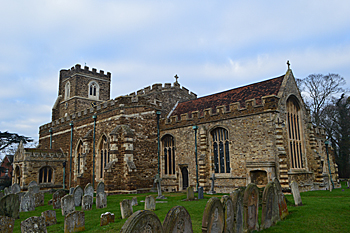Houghton Conquest Church Architecture
 The church from the south-east January 2016
The church from the south-east January 2016
There was, no doubt, a church in Houghton Conquest in Anglo-Saxon times. The earliest part of the present church of All Saints was built in the early 14th century. It is constructed of coursed ironstone rubble with ashlar dressing, these mostly in Totternhoe stone, with clay tiled roofs.
This surviving early work is in the Decorated style. The nave dates from the early 14th century with the chancel arch a little later. The chancel itself is late 14th century, showing the course of construction of the church. Both aisles are also 14th century. The font dates from the late 14th century and is octagonal.
The west tower dates from 1392, a contract signed on 1st November that year tells us that the masons were William Farele of Dunstable and Philip Lessy of Totternhoe. The work was to be completed in three years.
The nave was heightened in the 15th century when the clerestory was added, as were the aisles. All this is in the Perpendicular style. Some of the pews in the nave and aisles still have 15th century panelling and the stalls in the chancel, of the same period, have poppy-heads with misericords of dragons, angels, grotesques and dogs.
There is some medieval stained glass reset in the windows. There are also traces of 15th century wall paintings including Saint Christopher over the north aisle door and Christ in judgement over the chancel arch.